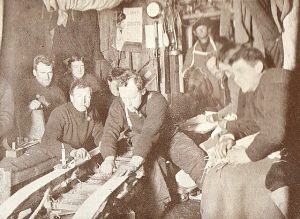Shackleton is back on offer in Co-op, and it’s still one of the finest whiskies you can imagine getting for £19.50.
Some years ago I went to the Whisky Stramash at the Surgeon’s Hall, and this new-at-the-time release was, for me, one of the standout drams of the entire event. A good whisky should tell a story, and this has one of the better ones.
In 1907, Ernest Shackleton (not yet Sir) and the crew of the British Antarctic Expedition buried a cache of supplies under the ice at the shore party’s overwinter hut. Shackleton himself is a fascinating character. Born in the wrong century, he should have been a buccaneer, swashing buckles and shivering timbers across the Spanish Main or some other such thing. Growing up in late-Victorian suburban London, he had to make do with the next best thing, which was becoming one of the greatest explorers of his age.

(Between epic expeditions he contented himself with a series of hare-brained moneymaking schemes of varying degrees of failure. At one point he ran a tobacconist’s shop around the corner from my old hotel.)
By 1907, the only bit of the planet that the British Empire hadn’t already stuck a flag in was the Antarctic, so that was the place to go. The climate there was significantly less hospitable than it would have been were Shackleton born early enough for privateering across the Caribbean, but he was a man who worked with what he had. And what he had included three cases of Mackinlay’s Rare Old Highland Malt Whisky.
A century later, these three crates of whisky were rediscovered frozen in the ice. So after extensive negotiations they were carefully dug out of the ice, defrosted, and flown back to civilization in what I understand to be contravention of several international treaties1It’s basically illegal to take anything out of Antarctica. Special arrangements were made, which I understand involved getting the whisky personally flown out on the distillery manager’s private jet.. Painstakingly recreated from samples of the original spirit, modern Shackleton’s whisky was released to some fanfare in 2011.
This is what I discovered at the Whisky Stramash. The specific single malt was no longer available2The Glen Mhor distillery was closed in 1983 and demolished 1986., so the modern version was a blended malt that carefully recreated the original flavour profile. Limited edition, sold inna wooden crate stamped BRITISH ANTARCTIC EXPEDITION and packed with straw as the original ones would have been. It cost me £100 and at the time was the single most expensive bottle of whisky I’d ever owned. So naturally I was too afraid to open it, and a few years later it got lost during a house move.
Don’t be like me, kids. Whisky is for drinking.
The fact that it’s now available most of the time for twenty-five quid in Asda ought to make me angry. It doesn’t, because it’s a bloody beautiful dram and I’m genuinely glad that it’s getting wider dissemination of the kind that it definitely deserves.
I recently discovered the original academic paper from when they scientifically analyzed the samples as part of the recreation process. It talks a lot about congeners and esters and phenols, concepts that I don’t understand nearly as much as I’d like. It all sounds fascinating but I was never good at chemistry at school.3When I’m making cocktails, I take care to describe what I’m doing as “applied chemistry”. What I found particularly interesting was that, after all this time, using things like gas chromatography and mass spectroscopy, they’ve been able to determine things as specific as the type of peat that was used (Orcadian, from the Isle of Eday) and the barrels used for maturation (first-fill American oak sherry casks, for more than five years). The things you can do these days. They’ve then been able to correlate their analyses with the historical records and work out, hypothetically, which of these Edwardian booze advertisements were telling porkies.
The results presented here significantly change our perception of the quality and character of Scotch malt whisky produced over 100 years ago. Malt whisky from this period was generally regarded as robust, peaty and too ‘heavy’ in style for ordinary consumption. Our analysis however describes a surprisingly light, complex whisky, with a lower phenolic content than expected.
Sensory and Chemical Analysis of ‘Shackleton’s’ Mackinlay Scotch Whisky4Pryde, J., Conner, J., Jack, F., Lancaster, M., Meek, L., Owen, C., Paterson, R., Steele, G., Strang, F. and Woods, J. (2011), Sensory and Chemical Analysis of ‘Shackleton’s’ Mackinlay Scotch Whisky. Journal of the Institute of Brewing, 117: 156-165. https://doi.org/10.1002/j.2050-0416.2011.tb00455.x
The general takeaway from the article, and from most reviews I’ve read, is that historical whisky was traditionally very heavy and peaty, whereas this Mackinlay brand is comparatively light and fresh, much more like a modern whisky. I’ve not been able to find any records describing how much personal interest Shackleton took in the specific type of booze he took along with him onna journey to the very ends of the Earth. But I like to think that, in this as in so many other things, he was a trailblazer.
Recently I’ve discovered that Shackleton whisky tastes, if anything, slightly better out of a hipflask. I can only speculate that this is exactly the kind of criterion valued by an Edwardian gentleman officer-adventurer. And I can confirm that it’s just the thing you want when you’re immersed in bloody freezing water.

I love living here, but sometimes going paddling at the beach is a chore.
Footnotes
- 1It’s basically illegal to take anything out of Antarctica. Special arrangements were made, which I understand involved getting the whisky personally flown out on the distillery manager’s private jet.
- 2The Glen Mhor distillery was closed in 1983 and demolished 1986.
- 3When I’m making cocktails, I take care to describe what I’m doing as “applied chemistry”.
- 4Pryde, J., Conner, J., Jack, F., Lancaster, M., Meek, L., Owen, C., Paterson, R., Steele, G., Strang, F. and Woods, J. (2011), Sensory and Chemical Analysis of ‘Shackleton’s’ Mackinlay Scotch Whisky. Journal of the Institute of Brewing, 117: 156-165. https://doi.org/10.1002/j.2050-0416.2011.tb00455.x
